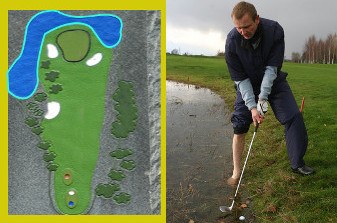
There’s no shame in hitting a ball into a water hazard. It happens to the best golfers in the world.
As a beginner, however, there’s no need to repeat the climactic scene from the movie Tin Cup, in which Kevin Costner's character (Roy McAvoy) hits shot after shot into a pond, then finally clears it with the last ball in his bag. Naturally, the ball goes into the hole.
In short: Depositing one or two into the water is plenty.
Under the Rules of Golf, there are two types of water hazards: standard (simply called water hazards) and lateral. There are slightly different rules for dealing with each kind, but as a beginner, there’s no need to dwell on handling a water ball in strict accordance with the rules during a casual round.

For you, the idea is to penalize yourself appropriately (one stroke) and set up the next shot so that you don’t hit into the water again. Whenever a ball finds the drink, go to the spot where it entered the hazard. If it flew in rather than rolling, make your best estimate as to where it crossed over the water’s edge.
Next, find a spot nearby where you can drop another ball. Make sure you can make contact from the spot – don’t drop on a large slope, into mud or tall grass, for instance. Also, it’s best that your next shot not have to cross directly over water. Give yourself a chance to get back into the fairway without risking another water ball.
Always add one shot to your score for a ball in the water. For example, if you hit your tee shot into a hazard and take a drop, your next shot will be your third on the hole.
Again, the idea is to minimize your lost balls (and frustration) while keeping the pace of play moving. Once you’ve advanced as a player, then you can – and should – begin following the letter of the law.
Golf Ball Videos:
– Compression Video
– Spin Video
– Dimples Video
– Golf Ball Brands Video
– Titleist Video
– Understanding Spin Video





